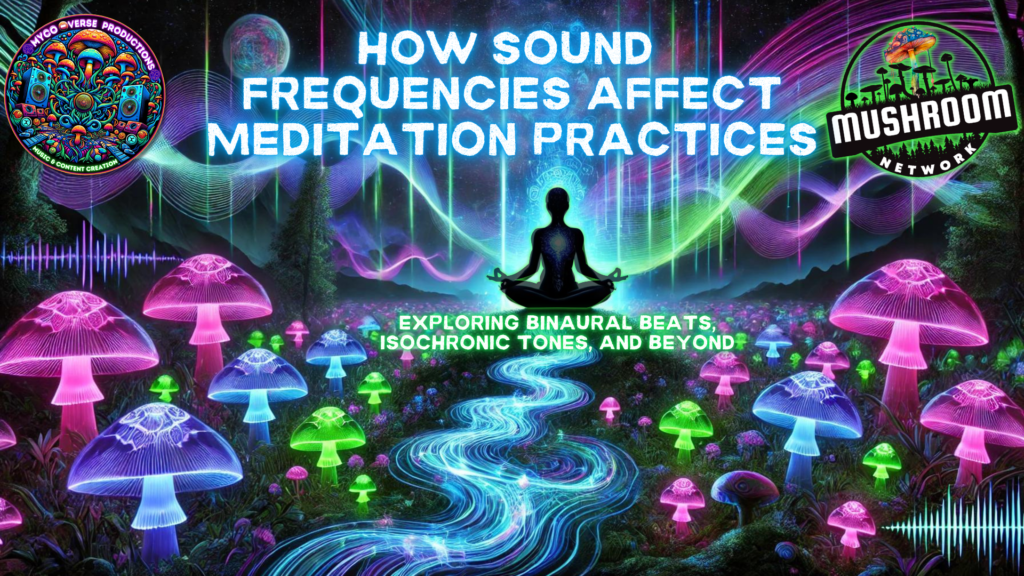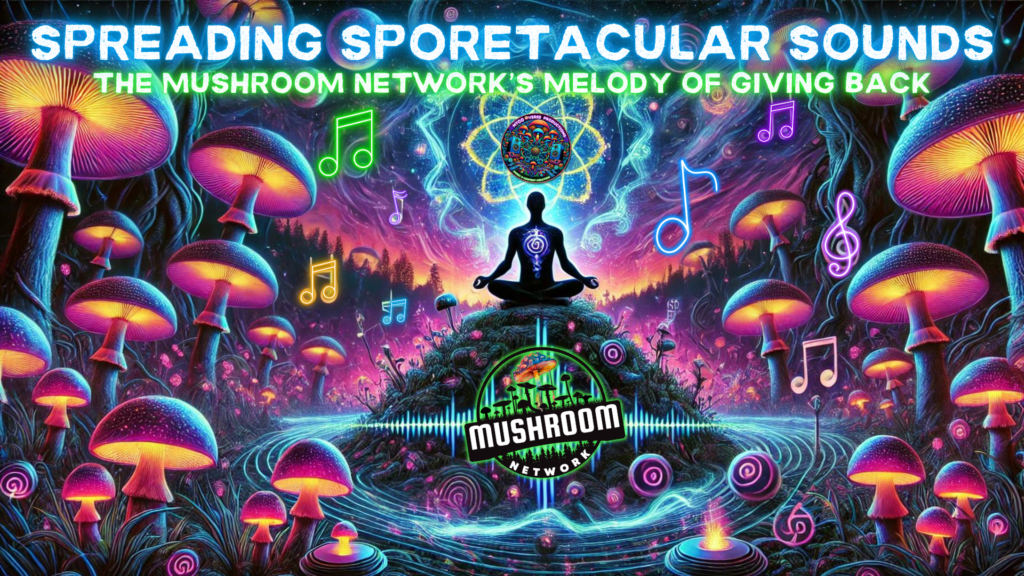“When music and mycology intertwine, the Myco-Verse echoes with a harmonious resonance.”
Meditation has been a practice of calming the mind and achieving deeper states of awareness for centuries. In recent years, modern technology has added new dimensions to this age-old practice by introducing sound frequencies into the equation. Binaural beats, isochronic tones, and other sound frequencies are becoming increasingly popular tools for enhancing meditation, helping practitioners dive into deeper states of relaxation and mindfulness. But how exactly do these sound frequencies work, and what effects do they have on our meditation practices?
Let’s explore the science and benefits of these auditory tools and how they can transform your meditation journey.

The Science of Sound Frequencies
Before diving into specific sound frequencies, it’s important to understand why sound can have such a powerful effect on our brains. The brain operates at different frequencies depending on its state of activity. These brainwave frequencies are measured in hertz (Hz) and can be categorized as follows:
- Delta Waves (0.5 to 4 Hz): Deep sleep and unconsciousness.
- Theta Waves (4 to 8 Hz): Deep relaxation, meditation, and creativity.
- Alpha Waves (8 to 12 Hz): Light relaxation, calmness, and a focused mind.
- Beta Waves (12 to 30 Hz): Active thinking, focus, and alertness.
- Gamma Waves (30 Hz and above): High-level information processing, focus, and cognitive function.
When you meditate, the goal is often to lower your brainwave activity from the fast-paced beta state (which corresponds to wakeful thinking) into the slower, more relaxed alpha or theta states. This shift is where sound frequencies like binaural beats and isochronic tones come in.

1) Binaural Beats: Syncing the Brain for Deeper Meditation
Binaural beats are one of the most popular sound tools for meditation. The term refers to an auditory illusion created when two different frequencies are played in each ear. For example, if one ear receives a sound at 210 Hz and the other receives a sound at 200 Hz, your brain will perceive a beat at the difference between these two frequencies—10 Hz in this case.
This perceived frequency difference encourages your brain to synchronize its activity to match the beat, a phenomenon called “entrainment.” Depending on the frequency, binaural beats can guide your brain into different states of consciousness:
- Delta (0.5 to 4 Hz): Promotes deep sleep and healing.
- Theta (4 to 8 Hz): Ideal for deep meditation, relaxation, and creativity.
- Alpha (8 to 12 Hz): Enhances calmness and mindfulness.
Why it works: Binaural beats essentially “trick” your brain into reaching the desired brainwave state. They are often used for stress reduction, improving focus, and achieving deeper meditative states. If you find it difficult to quiet your mind during meditation, binaural beats can act as a guide, helping your brain naturally drift into more relaxed states.
How to use binaural beats: To experience the full effects, use headphones and ensure that the frequencies for each ear are slightly different. You can find binaural beat tracks on various platforms, including YouTube and apps specifically designed for meditation.

2) Isochronic Tones: A Steady Beat for Mindfulness
Unlike binaural beats, isochronic tones don’t require headphones, making them a versatile tool for meditation. Isochronic tones are single tones that pulse on and off at regular intervals. The pulsing effect induces brainwave entrainment in much the same way as binaural beats do, encouraging your brain to sync with the rhythm.
Each pulse is designed to influence the brain toward specific states, such as relaxation or heightened focus. Here’s a breakdown of how different isochronic tones can impact your meditation:
- Theta (4 to 8 Hz): Enhances deep meditation and introspection.
- Alpha (8 to 12 Hz): Perfect for reducing anxiety and achieving a calm, mindful state.
- Beta (12 to 30 Hz): Useful for improving concentration during more active forms of meditation, like mindfulness-based stress reduction (MBSR).
Why it works: Isochronic tones offer a more distinct auditory cue for brainwave entrainment, making them effective for meditation. The steady rhythm provides a focus point for your mind, which can help reduce wandering thoughts during your practice.
How to use isochronic tones: You can listen to these tones through speakers or headphones. Many meditation apps and playlists offer isochronic tones tuned for specific outcomes, whether it’s deep relaxation or enhanced mental clarity.

3) Solfeggio Frequencies: Healing Through Ancient Tones
Solfeggio frequencies are a series of tones believed to have ancient roots in healing and spiritual practices. Each tone is thought to have specific effects on the mind and body. The most common solfeggio frequencies include:
- 174 Hz: Associated with reducing pain and stress.
- 396 Hz: Helps release fear and guilt.
- 528 Hz: Known as the “miracle tone,” believed to promote DNA repair and positive transformation.
- 639 Hz: Facilitates harmony in relationships and interpersonal connections.
- 852 Hz: Awakens intuition and higher consciousness.
These frequencies are often incorporated into meditation music to encourage healing, emotional release, and spiritual growth.
Why it works: Although the scientific evidence supporting solfeggio frequencies is limited, many practitioners report enhanced relaxation and emotional clarity when meditating to these tones. The belief is that solfeggio frequencies resonate with specific energy centers (chakras) in the body, helping to balance and heal.
How to use solfeggio frequencies: You can find tracks infused with solfeggio frequencies online. Play them during meditation to enhance the emotional and spiritual benefits of your practice.

4) 432 Hz: The Harmony Frequency
Many meditation enthusiasts believe that the frequency of 432 Hz, often referred to as the “universal frequency,” has a natural harmonic resonance with the universe and nature. Proponents of 432 Hz claim that it is more calming and healing than other musical tunings (such as the standard 440 Hz), encouraging deep relaxation and spiritual awareness.
Why it works: 432 Hz is said to resonate more closely with the vibrations of the earth, creating a feeling of harmony and peace. Though it may not work for everyone, some practitioners report heightened emotional clarity and a deeper connection to their meditation practice when listening to music tuned to 432 Hz.
How to use 432 Hz: Look for meditation music or soundscapes specifically tuned to 432 Hz. These can be used for mindfulness meditation, relaxation, or simply as a calming background for your daily life.
Lorem ipsum dolor sit amet, consectetur adipiscing elit. Ut elit tellus, luctus nec ullamcorper mattis, pulvinar dapibus leo.

The Power of Sound in Meditation
Sound frequencies are not just a passing trend; they offer scientifically-backed methods for enhancing meditation by altering brainwave states and helping practitioners achieve deeper levels of relaxation and awareness. Whether you’re drawn to binaural beats, isochronic tones, solfeggio frequencies, or the soothing harmonics of 432 Hz, incorporating these tools into your practice can elevate your meditation experience.
How to Get Started
If you’re new to sound frequencies in meditation, here’s a step-by-step guide to get started:
Choose Your Frequency: Decide whether you want to experiment with binaural beats, isochronic tones, or other frequencies. Consider your goal—whether it’s relaxation, focus, or emotional healing.
Set the Mood: Find a quiet space, dim the lights, and settle into a comfortable position.
Listen with Intention: Use headphones if necessary (for binaural beats), or play the tones through a speaker. Focus on your breath and allow the frequencies to guide your mind into a deeper state of meditation.
Practice Consistently: Like any meditation technique, using sound frequencies becomes more effective with regular practice. Experiment with different tracks to find what resonates with you the most.
Ready to dive into your next meditation session with sound frequencies? Check out relaxing soundscapes and binaural beats from The Mushroom Network on Spotify or explore more on their YouTube Channel. You’ll find a treasure trove of frequencies that can help you achieve deeper states of peace and mindfulness.

The Mushroom Network and the Power of Music
As an artist, The Mushroom Network taps into this incredible healing potential of music. Rooted in a deep understanding of the challenges of mental health—including ADHD, PTSD, and anxiety—the music produced isn’t just sound; it’s therapy. Each track is a journey through struggle and triumph, a melodic reflection of life’s ups and downs.
Through the fusion of sound and the natural world, The Mushroom Network aims to connect listeners with their own inner struggles and offer solace through shared experiences. In a world filled with chaos, their music offers an escape—an invitation to heal, reflect, and, ultimately, grow.
So whether you’re seeking a way to manage stress, break through the fog of depression, or find peace amidst trauma, remember that music is more than just entertainment. It’s therapy, it’s healing, and it might just be the key to unlocking your mental wellness.
Want to explore the musical journey further?
Dive deeper with MVP’s #1 Artist – The Mushroom Network on Spotify or subscribe to our YouTube Channel.

“Exploring the Myco-Verse: Uncovering hidden harmonies beneath every mushroom cap.”






